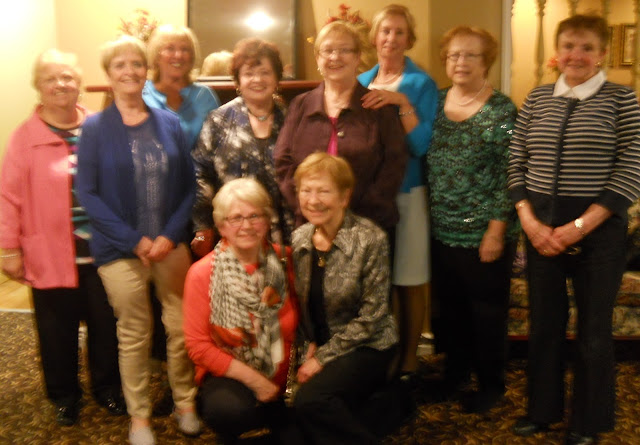The First St Patrick’s Convent School
was opened in 1856 and it served the educational requirements of the parish
extremely well. However, after more than
sixty years, it was evident that a new building was necessary to meet the needs
of the increasing number of pupils.
Therefore, plans were put into motion for the erection of a new
school. The new school was to be built
on Deanery Avenue and as St Patrick’s Parish, like every other Parish in
Newfoundland, had lost many young men and boys to the carnage of World War I,
it was decided that the new St Patrick’s Convent School would be built as a
Memorial to these young soldiers. On 4th
December 1921 the cornerstone of the memorial School was laid by Archbishop E P
Roche, assisted by the Parish Priest, Msgr William Kitchen and priests of the Parish.
This interesting advertisement appeared in a
local St John's newspaper on 15 July 1921. It
invited the populace to a “Grand Concert
and Comic Sketches”. This Grand
Concert, to be held at St Patrick’s Parish Hall, was in aid of the Memorial
School. The admission price was just 50¢.
 |
| The Newspaper ad for the fund raising concert in aid of the 'memorial' St Patrick's Convent School |
This
is the St Patrick’s Convent School, built as a Memorial to the young men of the
Parish who died in WWI. There was, on
the right hand side of the main door, a plaque indicating that the school was
indeed such a memorial. Many generations of west end girls and boys received
their education here but in due course this building also outlived its
usefulness as a school and, sadly, closed its doors. It was not the end though - at least not
yet!
 |
| St Patrick's Convent School, Deanery Avenue , A Memorial to men of the Parish who fell in WWI |
 |
| The plaque which was attached to the right hand side of the Deanery Avenue School entrance |
In
1978, the Sisters of Mercy reopened the School as a Residential Detoxification
Centre. It was renamed Talbot House, in
memory of Venerable Matt Talbot. In
time, Talbot House also closed and eventually the building was demolished.
We
have been given several names of parishioners who died in WWI. If you know of any other parishioners who
died in that war, please send their names to mcallistersmith@gmail.com if you would
like them added to the list below.
Carew, Pte John Joseph, Regimental Number
651, Son of David and Carrie Carew, 2 Brien St, St John’s
Constantine,
Pte Peter,
Regimental Number 563, Son of Peter and Hannah Constantine, 20 McFarlane St, St
John’s
Galgay,
Pte Francis Joseph, Regimental Number 892, Son of Francis and the late
Mary Galgay, 235 Water St West, St John’s
Holden,
Pte Patrick,
Regimental Number 555, Son of Joseph and Mary Alice Holden, Southside, St
John’s
Kennedy,
Pte Michael Francis, Regimental Number 255, Son of Nicholas and Margaret
Kennedy, 187 Lemarchant Road, St John’s
Pynn,
Pte Jack,
Regimental Number 4036, Son of Daniel and Margaret Pynn, 329 Water St West, St
John’s
Woodford,
Pte Francis Patrick, Regimental Number 364, Son of John Joseph and Sarah
Jane Woodford, 7 Convent Square, St John’s
 |
| Padre Thomas Nangle |
We also remember Fr Thomas Nangle, a priest of St
Patrick’s Parish from 1914 to 1916.
After the bloodbath of Beaumont Hamel in 1916, Fr Nangle enlisted and
became the Newfoundland Regiment's Catholic Chaplain. We know that in war, Chaplains don’t carry arms but Padre Nangle
was beside his men tending the wounded, burying the dead and encouraging the
battle weary.
We Newfoundlanders owe a
great debt to Padre Thomas Nangle. During the War he brought comfort to the soldiers and their families. After the War Padre Nangle was involved with
the identification and re-interment of the Newfoundlanders who had died in
battle. He was also the driving force
behind the creation of the beautiful Newfoundland Memorial Park at Beaumont Hamel in France. This exceptional Newfoundlander, Padre Thomas Nangle, died in Rhodesia on 4th January
1972.
Today,
St Patrick’s Convent School, Deanery Avenue, built as a memorial to our heroic
dead of WWI, is just a memory. Sadly,
nothing remains but an empty space. No
trace of this Memorial can be seen. It
exists only in the mind’s eye of the diminishing number of westenders who spent
their formative years as pupils there. So, on this Memorial Day, 1st July 2015, we remember those who
have died in all Wars and Conflicts but we remember especially our own heritage. We remember the parishioners who came before
us; those who gave their lives in war and the families who grieved for them. We
remember the people who dreamed a St Patrick’s Convent Memorial School to
honour our fallen parishioners and we remember the good people who worked so hard
to make that dream a reality. Yes, the
School is
gone but the memories remain. Let us
honour the memories!
 |
| This grassy bank is where St Patrick's Convent School, a Memorial to parishioners who died in WWI, once stood |









